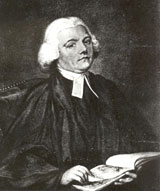Gilbert White


This article does not have any sources. (May 2020) |
Gilbert White (18 July 1720 – 26 June 1793) was a pioneering English naturalist and ornithologist.
Early life and education
[change | change source]White was born in his grandfather's vicarage at Selborne in Hampshire. He was educated by a private tutor in Basingstoke before going to Oriel College, Oxford University. He obtained his deacon's orders in 1746, being fully ordained in 1749.
Then he held several curacies in Hampshire and Wiltshire, including Selbourne. White also held the office of Junior Proctor at Oxford and was Dean of Oriel College. In 1784 he became curate of Selborne for the last time, remaining so until his death.
Publications
[change | change source]White is best known for The Natural History and Antiquities of Selborne (1789). This was a collection of his letters to Thomas Pennant, the leading British zoologist of the day, and the Hon. Daines Barrington, an English barrister and Fellow of the Royal Society. These letters contained White's discoveries on local birds, animals and plants. White believed in observing birds rather than collecting specimens. He was one of the first people to separate the similar-looking Chiffchaff, Willow Warbler and Wood Warbler by means of their song.
White is regarded by many as England's first ecologist and one of the founders of modern respect for nature.
- White, Gilbert 1789. The Natural History and Antiquities of Selborne, in the County of Southampton: with engravings and an appendix. London: Printed by T. Bensley; for B. White and Son.
- White, Gilbert 1795. A Naturalist's Calendar, with observations in various branches of natural history, extracted from the papers of the late Rev. Gilbert White of Selborne, Hampshire, Senior Fellow of Oriel College, Oxford. Never before published. London: printed for B. and J. White, Horace's Head, Fleet Street. This posthumous collection of previously unpublished material was put together by J. Aikin.
